Picture a vineyard…
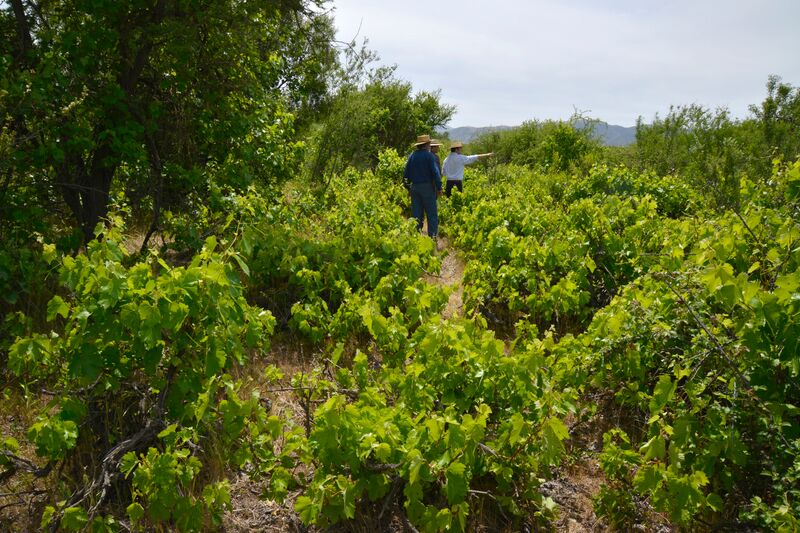
We stop by the head of a path, walk through a gate and promenade through woods of pine, eucalyptus and local trees until the woods became bushes, snagging brambles, and the ambling became stumbling, scratching a way through twigs, thorns and snappy branches …
Two roads diverged in a yellow wood,
And sorry I could not travel both
And be one traveller, long I stood
And looked down one as far as I could
To where it bent in the undergrowth
Deeper in, treading amongst vines spooled on the ground, seeing grapes pip-to-pip with blackberries and sloes, others enmeshed deep in bramble bushes, whilst other vines climb higgledy-piggledy up tall trees creating a wilderness – a happenstance of vines.
We emerge into a clearing where we are greeted by the remainder of the smiling family and two tables laden with a medley of edibles – juicy olives, guacamole, tomato and coriander salsa, almonds, moist jamon, baskets of delicious bread and two large buckets filled with 2009 & 2010 Carignan on ice. We attacked the table like hungry savages, guzzled pur Carignan nectar and were led dreamily through the rest of the vineyard which stretched through the wild heath. Here a grape, there a grape, not everywhere a grape-grape. Yields, as a result, are a piffling 5 hl/ha. We were greeted by a group of horses who are the de facto vineyard workers, nibbling the tender shoots around the vines.
This is beyond organic or biodynamic viticulture. It is a non-cultured vineyard, a tiny part of a greater whole. The philosophy of Villalobos is based on absolute respect for the environment where the grapes are produced. The vineyard operation involves the use of horses and natural forms of herb control in order to keep the natural balance. We learned that harvesting these precious few grapes was back-breaking and risky work. If you are not up a ladder, you are gingerly plucking the odd grape from the scratchy embrace of the bushes, armed with masks and gauntlets to ward off bees, thorns…
This is Villalobos, the wild vineyard.


Please tell us a little bit about your family?
The family consists of the mother, Rita Encina, professional ceramist, the father Enrique Villalobos, and their sons, Martin Villalobos, a civil industrial engineer, Alejandro Villalobos, Professor of Philosophy, and Rolando Villalobos, also a civil industrial engineer.
Each family member has his or her own professional activity, but they come together when working with the vineyard.
What is the Valley of the Artists?
The ‘Valley’ is a place where Chilean artists such as sculptors, painters and engravers have their place of work. The valley is located within the Chilean agricultural fields in the district of Lolol in the Colchagua Valley. This is a unique project in Latin America, one which welcomes artists who have built their homes and workshops in the Valley.

The Valley is open to the public during the day for those who wish to visit the artists’ workshops. Moreover, there is a collective outdoor space and park, showing a series of different artworks. There is a community house at the entrance to park which has an exhibition hall and a large terrace where you can host seminars and cultural promotion activities.
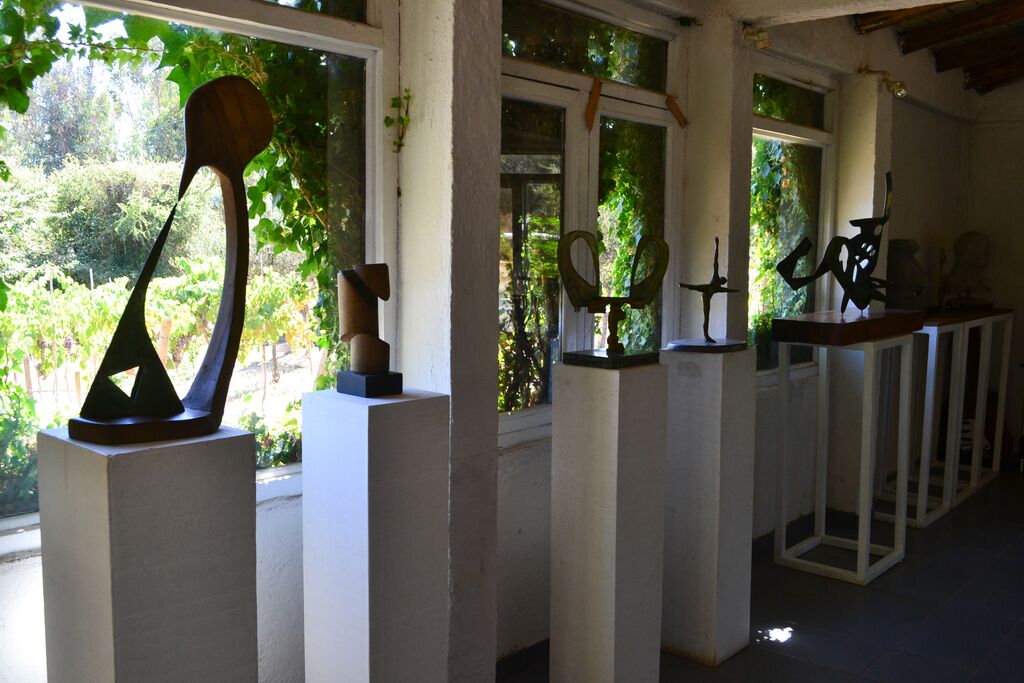
This is where the family of the sculptor Enrique Villalobos took up permanent residence with his bronze foundry. Part of the workshop was destroyed by the earthquake of 2010, but now is being rebuilt and restored. It is our duty to fall and stand all over again.
Where is the wild vineyard?

The vineyard is located five kilometres from the Valley of the Artists within the Villalobos estate, which in turn is close to the village of Ranguili. It is part of the Colchagua Valley appellation of origin. Colchagua is a region whose proximity to the coast allows it to enjoy dry summer days and refreshing temperatures at night. The vineyard is essentially about the Carignan variety, and was planted during the 1940’s and 50’s.
How did you discover it?
The vineyard already existed when the Villalobos family arrived in the valley. They knew of its existence, but horses used to eat the grapes before it became the vineyard that it is today!
What was it like when you first saw it? Can you describe it to those who have never seen photos of it?
I was surprised myself when I first saw the vineyard. Villalobos vines have never been treated in the production process; indeed, the vines have always grown wild and free from any chemical processes for sixty years amongst native Chilean flora such as Maitenes, rosehip, Culenes, pine trees, blackberry bushes, etc.
Given this context, our vineyard wishes to distance itself from the traditional industrial monoculture. Our main goal is to produce wines which reflect the seasonal conditions and qualities of our terroir, taking advantage of the organic and wild characteristic of the aged vines. This unique terroir allows us to harvest grapes which give the wine an aroma that is perfectly harmonized with the Chilean countryside.
When I visited a few years ago I thought the vineyard had a wonderful energy. Can you describe the feelings that it engenders in you and your family, and why it is important to preserve such places?
The world is at this very moment is facing one of its most critical periods of history with the industrialisation of the land and global warming. All who participate in agricultural activities, winemakers and viticulturalists amongst them, must take responsibility for the planet’s ecological balance.
Our maxim is to respect is Mother Earth (‘Pachamama’) in every way, and our activities as vignerons show that we are determined not to compromise these principles.

Thus we pay due attention to the soil and its environment and to the wine that the earth wishes to give us – with all its singularities in each and every vintage. Let’s say that we’d rather discover the fruit of a forest than realise the production of a commercial vineyard.
What is the climate like? And the countryside around here?
The vineyard is located 30 km from the Pacific coast, settled in a warm, temperate climate with six to eight months of dry season and up to 20-degrees temperature differences, particularly in the summer months.
During the colonization in the seventeenth century the first parcels of land were created and given by the King of Spain to his most distinguished officers. The most desirable were the lands of Colchagua with their beautiful climate, ideal for agriculture and livestock rearing.
It was on these very lands that the Republic of Chile was founded (In 1810 Chile finally gained independence from Spain). Since then, the most traditional families in the country acquired land in the valley and built beautiful mansions, which have become our patrimony and attract visitors from all over.
Tell us about the grape variety. Have you been able to do any historical research into when the vines were first planted and by whom?
The Carignan vine is of French origin. It was brought to Chile by the Government in 1940 in order to give more weight to the Pais variety which had been introduced by the Spanish conquistadors in the middle of the 16th century.
Details of the actual arrival of Carignan in Chile are still hazy, but most winemakers would concur that the first stocks were brought from France in 1939, after the earthquake of Chillán.
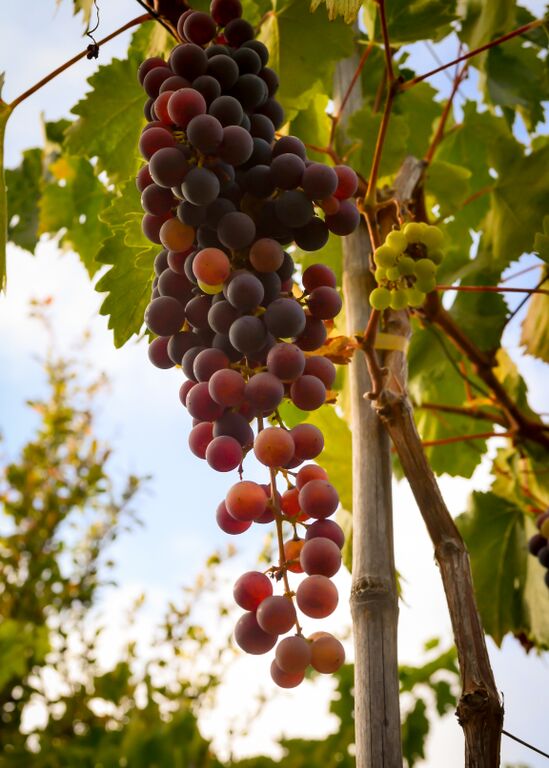
As mentioned Carignan was introduced in order to improve the characteristics of traditional wines in the area, as this new variety would boost colour, provide body and, above all, confer freshness to the wine production.
This is a late budding variety, fairly resistant to spring frosts, with good colour intensity and concentration of sugars. It produces velvety, fleshy wines with intense colour and mild astringency in youth, but with ageing can become silky and tender.
When did you decide you wanted to make wine from the grapes?
We decided to make wine originally in 2007 with a small production for the use of family and our friends and were supported in this by our friend Mathieu Rousseau (who recently died). But now we continue with all the momentum of wild vines. Our first commercial harvest was in 2009 – with great success.
How did you go about it? Did you map the entire vineyard?
We were unable to map the vineyard due to the wild state of it. It was very difficult in the beginning with many complicated decisions to make. We received a huge amount of advice. In the end, however, we ignored 99% of it and decided to follow our beliefs in organic farming and natural winemaking.
How is the vineyard maintained throughout the year? Do you prune or trim – or leave it to nature?
No type of management in the vineyard is done, no irrigation, no pruning, no application of pesticides nor herbicides. Horses are responsible for the natural pruning of the wild vines.
Tell us about the horses!
The horses are – and remain – a precious element within the family life and an invaluable asset at work and have become essential to support the endeavours in the field.

We treat them with respect and love; they respond in kind and learn very quickly.
Our vineyard does not use any fossil fuel for farming, so we try to have most of the work done with the horses.
They also prune the vines by nibbling the branches. These are a real “treat” for them, and what remains after this are the last two buds which are required for producing the grape clusters in the following year.
Once the harvest is completed (in May each year), the horses enter the vineyard and leave their droppings (which are packed with nutrients) amongst the vines.
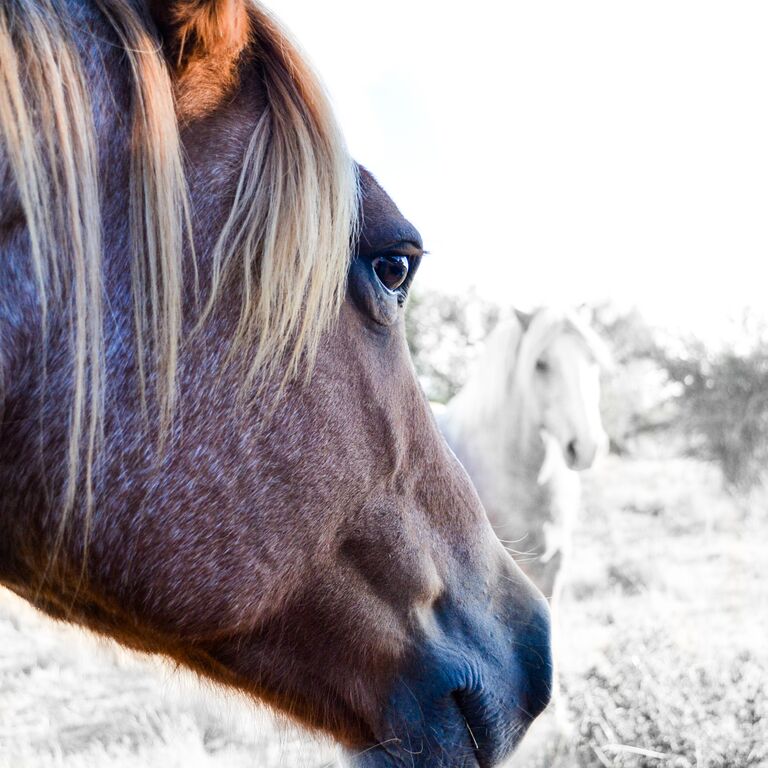
They don’t crush the soil as a tractor would do, and thus produce an organic layer in the soil which is rich in microorganisms and productive bacteria.
Describe how you harvest the grapes? What proportion of the vines grow up trees? What equipment do you need?
The harvest is manual and very difficult because most of the vines grow amongst trees with thorns. There is an inventory of how many vines grow on trees. No machinery is used.
How long does it take to harvest the whole vineyard? How many people do you have helping?

Usually, the harvesting process takes 3 full days, with a team of 20 people, most of whom are family and friends.
Do you know what yields you get (approximately)?
There is no way to control or account exactly for the yield per hectare since the vineyard is totally heterogeneous.
What sort of equipment do you have in the winery? Would you please describe how you make the wine?
In the vineyard there is no type of team, all the work is done manually, in the winery we only have a small despalilladora (destemmer). The grapes are processed in this, and the fermentation tank is open; we use native yeasts to ferment (no additions, no temperature control); we don’t add SO2 either at the harvest or during fermentation.
What do you mature the wine in?
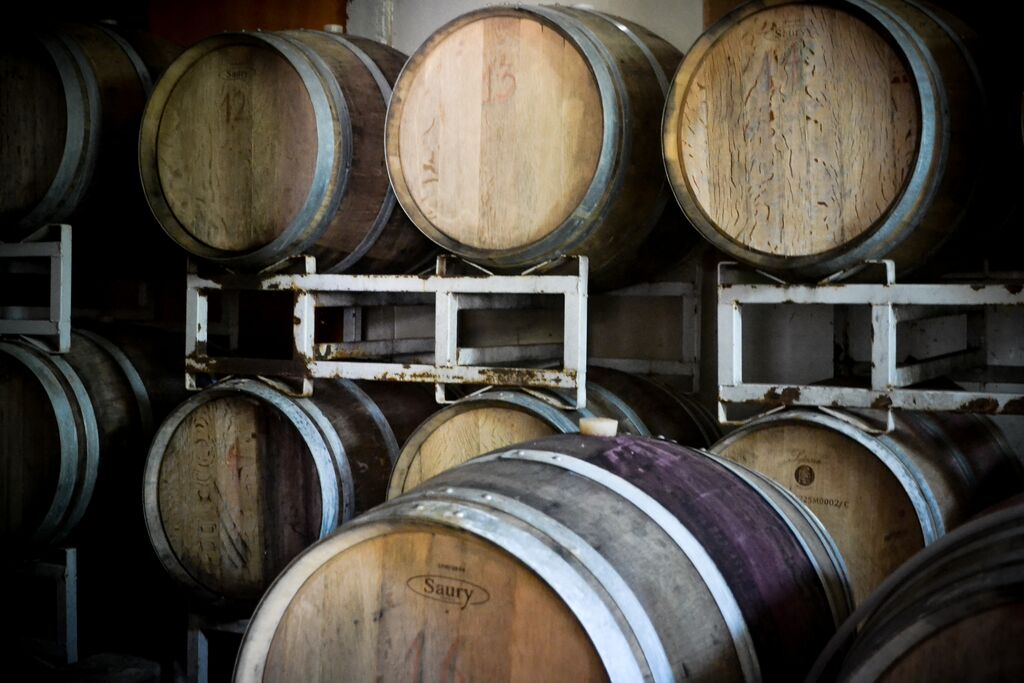
We use second hand French oak barrels and handle the wine gently so as not to disturb the fruit. The juice is neither filtered nor fined and a small amount of SO2 is added only at the bottling stage.
Has the style of the wine changed over the vintages? Do you have specific wine in mind or do you let nature takes its course?
Yes, the wine has changed and we are making small changes in the methods to better accommodate our terroir. The idea is that it is nature that speaks in the bottle.
What do other Chilean winemakers think of what you are doing? Is vine growing still largely a monoculture and winemaking an industrial activity? Have you noticed a greater number of small artisan growers bottling wines to sell in the last few years?
Generally, the largest vineyards in the country continue to approach wine as they always have done. There are small experiments to replicate what the artisan producers are achieving.
Recently, the production of wines has stalled owing to the oversupply of the big producers (for bulk wine)
There is an increased interest in small producers as the public is becoming more interested in trying new things and seeking out better quality.
How do you see the wine evolving? I think the Villalobos Wild Vineyard wine would work very well in tinajas. What do you think?
We tasted bottles of 2008 and 2009 in 2015, and the result is amazing. The wine has a strong potential to evolve.
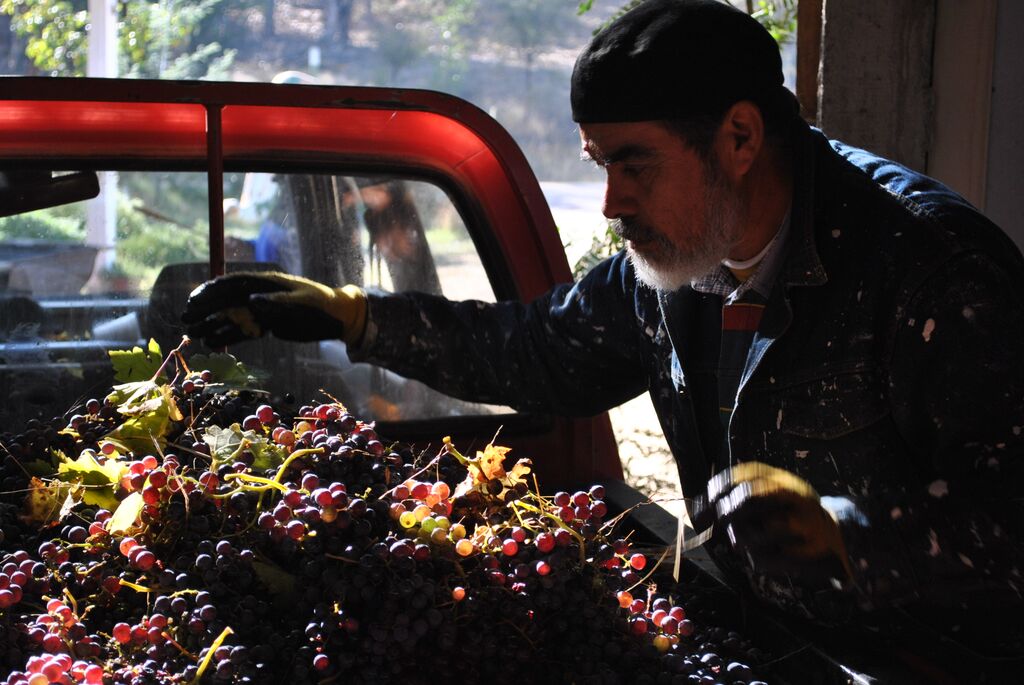
It may work well in pots, however we believe that the rounding of tannins, and the subtlety and complexity that we derive from maturation in barrels suits our purpose which is to preserve the aromatic intensity of the fruit.
Can you say something about the similarities and differences between being an artist and a vigneron?

Clearly there is a strong similarity between the two activities. The very process of investigation; the encounter with, and shaping of raw materials. The nature of adaptability. The culmination of process and transformation into something original and unique that people can appreciate and respond to in their own way. That is alchemy. That is creation.

